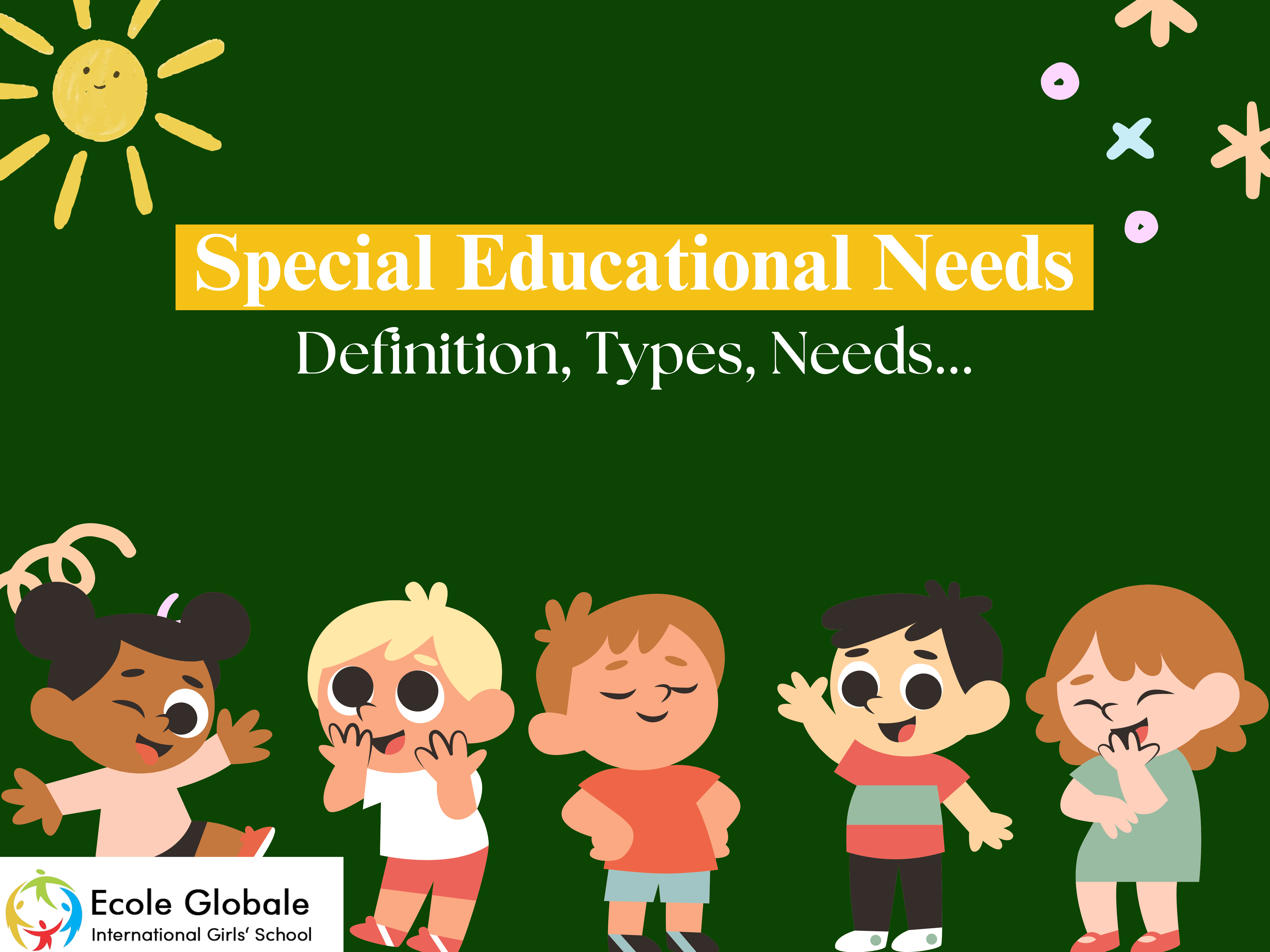Special educational needs (SEN) refer to the requirements of children who have learning difficulties or disabilities that make it harder for them to learn than most children their age. At Ecole Globale Schools, we understand the importance of recognizing and addressing these needs to ensure every child receives the education and support they deserve. This article provides a comprehensive overview of Special educational needs (SEN), covering definitions, types of difficulties, support mechanisms, historical context, and instructional strategies.
Defining Special Educational Needs

Special educational needs encompass a range of learning problems or disabilities that make it more difficult for children to learn compared to their peers. These difficulties can affect various aspects of a child’s education, including:
- Schoolwork: Struggling with reading, writing, number work, or understanding information.
- Communication: Challenges in expressing themselves or understanding others.
- Behavior: Difficulties in behaving properly or interacting with peers and adults.
- Physical and Sensory Needs: Disabilities that impact a child’s ability to participate in school activities.
Types of Special Educational Needs

Children with SEN can face challenges in one or more areas. Here are some common types of difficulties:
- Learning Difficulties: Problems with thinking, understanding, reading, spelling, and other academic activities.
- Emotional and Behavioral Difficulties: Issues with self-esteem, confidence, following rules, and behavior in school.
- Speech, Language, and Communication: Difficulties in expressing thoughts, understanding others, making friends, and organizing themselves.
- Physical or Sensory Disabilities: Visual or hearing impairments, medical conditions, or physical disabilities that affect learning.
Support in Schools

Schools play a crucial role in supporting children with SEN. They provide additional help and resources to ensure these children can achieve their full potential. Key support mechanisms include:
- Individualized Instruction: Tailoring lessons to meet the specific needs of each child.
- Specialists: Utilizing speech therapists, occupational therapists, and other professionals to support children’s needs.
- Parental Involvement: Engaging parents in the decision-making process and keeping them informed about their child’s progress.
Monitoring Progress
Teachers at Ecole Globale Schools plan lessons carefully, considering each child’s unique needs. They monitor progress and adjust teaching methods to ensure every child can succeed. This might involve:
- Providing extra help in specific subjects.
- Using different teaching materials and methods.
- Collaborating with specialists to address specific challenges.
Historical Context of Special Educational Needs

The development of special education has a rich history, evolving from ancient care practices to modern educational techniques. Key historical milestones include:
- Renaissance Innovations: Techniques for educating deaf individuals were developed, leading to broader interest in special education.
- 19th Century Advances: Establishment of schools for the blind and development of methods for educating children with intellectual disabilities.
- Modern Developments: Universal special educational needs programs in developed countries, with a focus on individualized instruction and inclusive education.
Key Figures in Special Education
- Pedro Ponce de León: Pioneer in teaching deaf pupils to speak, read, and write.
- Valentin Haüy: Known as the “father and apostle of the blind,” he established the first school for the blind in Paris.
- Jean-Marc-Gaspard Itard: Worked with children with intellectual disabilities, laying the groundwork for modern special education methods.
Implementing Special Education Programs

Effective special educational needs programs require careful assessment and individualized approaches. Key aspects include:
- Diagnosis and Assessment: Identifying the specific needs of each child through comprehensive evaluations by medical and educational professionals.
- Instructional Strategies: Using tailored teaching methods to meet the unique needs of each child, including techniques like Braille for the blind and visual methods for the deaf.
- Grouping and Integration: Special classes, resource rooms, and inclusive education models to ensure children with SEN receive appropriate support.
Inclusive Education
There is a growing trend towards inclusive education, where children with SEN are integrated into regular classrooms. This approach promotes social inclusion and provides opportunities for all children to learn together. Key benefits include:
- Social Development: Encourages interaction between children with and without SEN, fostering understanding and empathy.
- Academic Achievement: Inclusive education models have been shown to benefit both children with SEN and their peers.
- Holistic Growth: Focuses on the overall development of the child, including social, emotional, and academic aspects.
Parental Involvement

Parents play a vital role in supporting their child’s education. It is essential for parents to be informed and involved in decisions affecting their child. Steps parents can take include:
- Communicating with Teachers: Regularly discussing their child’s progress and any concerns with teachers and specialists.
- Seeking Additional Support: Exploring additional resources and support services, such as educational psychologists and support groups.
- Advocating for Their Child: Ensuring their child’s needs are met and their rights are protected within the educational system.
Practical Tips for Parents
- Stay Informed: Keep up-to-date with developments in special education and available resources.
- Be Proactive: Address any concerns early and seek support as needed.
- Collaborate: Work closely with teachers and specialists to create a supportive learning environment for your child.
Conclusion
Understanding and addressing special educational needs is crucial for ensuring that every child has the opportunity to succeed. At Ecole Globale Schools, we are committed to providing a supportive and inclusive environment for all students. By recognizing the unique needs of each child and involving parents in the educational process, we can create a nurturing and effective learning environment. Through tailored instruction, specialist support, and a focus on inclusive education, we strive to help every child reach their full potential.
Frequently Asked Question
Q1. What are Special Educational Needs (SEN)?
Answer. SEN refers to learning difficulties or disabilities that make it harder for children to learn compared to their peers.
Q2.What types of difficulties fall under Special Educational Needs (SEN)?
Answer. SEN includes learning difficulties, emotional and behavioral issues, speech and communication challenges, and physical or sensory disabilities.
Q3. How can schools support children with SEN?
Answer. Schools offer individualized instruction, specialist support, and involve parents in the educational process to address Special Educational Needs (SEN).
Q4. What is inclusive education for SEN students?
Answer. Inclusive education integrates Special Educational Needs (SEN) students into regular classrooms, promoting social development and academic achievement.
Q5. How can parents support their child with SEN?
Answer. Parents can stay informed, communicate with teachers, seek additional support, and advocate for their child’s needs.









